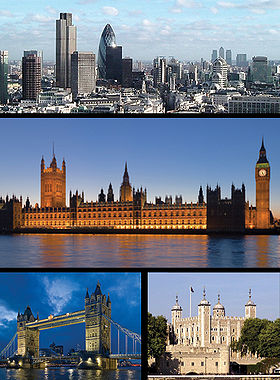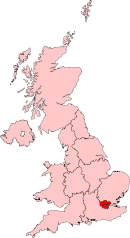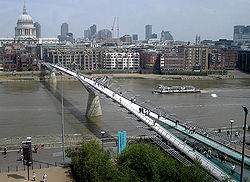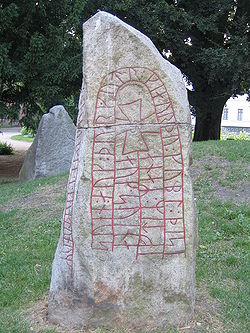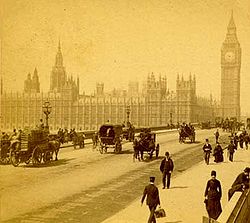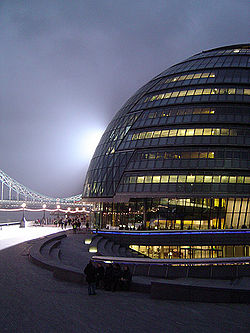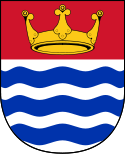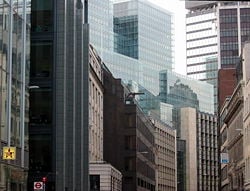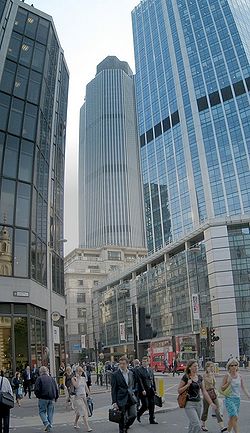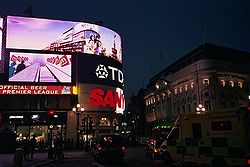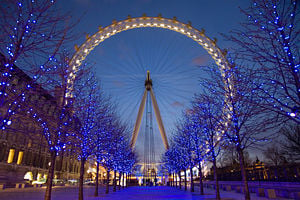London
| London | |
| Greater London | |
| Top: City of London skyline, Middle: Palace of Westminster, Bottom left: Tower Bridge, Bottom right: Tower of London. | |
| London region shown within the United Kingdom | |
| Coordinates: {{#invoke:Coordinates|coord}}{{#coordinates:51|30|28|N|00|07|41|W|type:city | |
|---|---|
| name= }} | |
| Sovereign state | United Kingdom |
| Constituent country | England |
| Region | London |
| Districts | City and 32 boroughs |
| Settled by Romans | as Londinium c. AD 50 |
| Government | |
| - Regional authority | Greater London Authority |
| - Regional assembly | London Assembly |
| - Mayor | Boris Johnson |
| - HQ | City Hall |
| - UK Parliament - London Assembly - European Parliament | 74 constituencies 14 constituencies London constituency |
| Area | |
| - Greater London | 609 sq mi (1,577.3 km²) |
| Elevation [1] | 79 ft (24 m) |
| Population (2006 est.)[2], [3][4], [5] | |
| - Greater London | 7,355,400 |
| - Density | 12,331/sq mi (4,761/km²) |
| - Urban | 8,278,251 |
| - Metro | 12–14 million |
| - Demonym | Londoner |
| - Ethnicity (2005 Estimates[6]) |
Ethnic groups
|
| Time zone | GMT (UTC0) |
| - Summer (DST) | BST (UTC+1) |
| Post code | Various |
| Website: www.london.gov.uk | |
London (pronunciation ▶; IPA: /ˈlʌndən/), situated in south-eastern England at the head of the River Thames estuary, the largest urban area and the capital of the United Kingdom.
An important settlement for two millennia, London's history goes back to its founding by the Romans. The city's core, the ancient City of London, still retains its limited mediaeval boundaries; but since at least the 19th century the name "London" has also referred to the whole metropolis which has developed around it.
It is one of the world's leading business, financial, and cultural centres, and its influence in politics, education, entertainment, media, fashion and the arts all contribute to its status as a major global city.
Geography
The term “City of London”, or “the City”, applies to a small area known as the Square Mile (2.59 square kilometers) that was the original settlement (ancient Londinium) and is now part of the financial and business district of the metropolis.Greater London covers an area of 609 square miles (1579 square kilometers), making it the 37th largest urban area in the world.
London lies within the bowl of the London Basin, 50 miles (80km) upriver from its mouth at the Nore, where the English Channel joins the North Sea. Most of London's built-up area lies on the Tertiary and younger sediments, while only a small part of south London (Sutton, Banstead and Croydon) lie on the chalk backslope of the North Downs. The centre of the basin is dominated by the modern valley of the Thames, which forms a level corridor running from west to east. The modern floodplain is around half a mile wide to the west of Greater London, expanding to two miles wide to the east. This is bordered by slightly higher and older terraces often extending several miles from the floodplain, for example in Hounslow and Southwark.
London has a temperate marine climate, like much of the British Isles, with regular but generally light precipitation throughout the year—unlike the rest of the UK and even the nearby coast. The warmest month is July, with an average temperature range at Greenwich of 56.5 to 73.0 °F (13.6 °C to 22.8 °C).
The Thames, a navigable river flowing west to east across the London Basin, is tidal rendering London vulnerable to flooding. Larger left bank tributaries include the Colne, Crane, Brent, Lea or Lee, Roding, Rom (lower reaches known as the Beam) and Ingrebourne. Significant right bank tributaries include the Mole, Wandle, Ravensbourne, and the Darent and its tributary the Cray which together form part of the eastern boundary of Greater London.
A number of canals or canalised rivers have been constructed in the London area, mostly in the late 18th and early 19th centuries. These were originally for goods traffic, which has largely ceased.
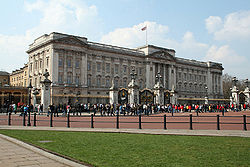
London began on the Thames' north bank and for many centuries London Bridge was the only bridge in or close to the city. Because of this the main focus of the city was on the north side of the Thames. When more bridges were built in the 18th century, the city expanded in all directions as the mostly flat or gently rolling countryside presented no obstacle to growth.
The City of London is on the site where the Roman fort of Londinium, founded in the first century C.E., stood. St Paul’s Cathedral stands on the western edge of the City, while the Tower of London, the repository of the Crown Jewels, lies to the south-east. West of Tower Bridge is London Bridge.
To the east and north-east of the City are the working-class districts of the East End, which is the area closest to the original Port of London, and is known for its high immigrant population, as well as for being one of the poorest areas in London. London's new financial and commercial hub is the Docklands area to the east of the City, on the north bank of the Thames, dominated by the Canary Wharf complex. West of the City lie the Inns of Court, the legal district, and Fleet St, once the home of Britain’s press. Other businesses locate in the City of Westminster, the home of the UK's national government and the well-known Westminster Abbey. The West End, to the west of the City, contains most of the best-known theatres and shopping districts. The West London area is also known for fashionable and expensive residential areas such as Notting Hill, Knightsbridge and Chelsea—where properties can sell for tens of millions of pounds.
London's vast urban area is often described using a set of district names (e.g. Bloomsbury, Knightsbridge, Mayfair, Whitechapel, Fitzrovia). These are either informal designations, or reflect the names of superseded parishes and city wards. Such names have remained in use through tradition, each referring to a neighbourhood with its own distinctive character, but often with no modern official boundaries. Since 1965 Greater London has been divided into 32 London boroughs in addition to the ancient City of London.
The 13 inner London boroughs are Camden, Hackney, Hammersmith and Fulham, Haringey, Islington, Kensington and Chelsea, Lambeth, Lewisham, Newham, Southwark, Tower Hamlets, Wandsworth, and the City of Westminster. The 19 outer boroughs are Barking and Dagenham, Barnet, Bexley, Brent, Bromley, Croydon, Ealing, Enfield, Greenwich, Harrow, Havering, Hillingdon, Hounslow, Kingston upon Thames, Merton, Redbridge, Richmond upon Thames, Sutton, and Waltham Forest.
History
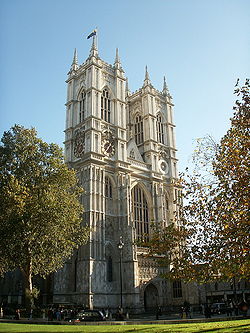
Roman rule
During prehistoric times, London was most likely a rural area with scattered settlement. Londinium was established as a civilian town by the Romans about seven years after the Roman invasion of Britain in 43 C.E. Early Roman London occupied a relatively small area, roughly equivalent in size to Hyde Park. In around 60 C.E., it was sacked by the Iceni led by their queen Boudica. However, the city was quickly rebuilt as a planned Roman town.
During the second century Londinium was at its height and replaced Colchester as the capital of Roman Britain (Britannia). Its population was around 60,000 inhabitants. The Romans may have marked the centre of Londinium with the London Stone, still visible on Cannon St. It boasted major public buildings, including the largest basilica north of the Alps, a governor's palace, temples, bath houses, amphitheatre and a large fort for the city garrison.
At some time between 190 and 225 C.E. the Romans built the defensive London Wall - around the landward side of the city. In the late third century, Londinium was raided on several occasions by Saxon pirates. This led, from around 255 onwards to the construction of an additional riverside wall.
Anglo-Saxons
In 410 C.E., the Roman occupation of Britain came to an end. The area's strategic location on the River Thames meant that the site was not deserted for long. From the sixth century, Anglo-Saxons began to inhabit the area. By the 600s, the Anglo-Saxons had created a new settlement called Lundenwic approximately 1000 yards (1km) upstream from the old Roman city, around what is now Covent Garden. London revived, and by the eighth century trade was prospering again across the English Channel and the North Sea.
A Viking raid in 851 destroyed that city. A Viking occupation 20 years later was short-lived. Alfred the Great, the new King of England, established peace and moved the settlement within the defensive walls of the old Roman city (then called Lundenburgh). The original Saxon city of Lundenwic became Ealdwic ("old city"), a name surviving to the present day as Aldwych, which is in the modern City of Westminster.
Subsequently, under the control of various English kings, London once again prospered as an international trading centre and political arena. However, Viking raids began again in the late 10th century, and reached a head in 1013 when they besieged the city under Danish King Canute and forced English King Ethelred the Unready to flee. In a retaliatory attack, Ethelred's army achieved victory by pulling down London Bridge with the Danish garrison on top, and English control was re-established.
Canute took control of the English throne in 1017, controlling the city and country until 1042, when his death resulted in a reversion to Anglo-Saxon control under his pious stepson Edward the Confessor, who re-founded Westminster Abbey and the adjacent Palace of Westminster. By this time, London had become the largest and most prosperous city in England, although the official seat of government was still at Winchester.
The City of London (corresponding closely to the area of Roman London) together with Westminster, comprised the core of the built-up area in early mediaeval times.
Medieval London
Following a victory at the Battle of Hastings, William the Conqueror, the then Duke of Normandy, was crowned King of England in the newly-finished Westminster Abbey on Christmas Day 1066. William granted the citizens of London special privileges, while building a castle in the south-east corner of the city to keep them under control. This castle was expanded by later kings and is now known as the Tower of London, serving first as a royal residence and later as a prison.
In 1097, William II began the building of Westminster Hall, close by the abbey of the same name. The hall proved the basis of a new Palace of Westminster, the prime royal residence throughout the Middle Ages. Westminster became the seat of the royal court and government (persisting until the present day), while its distinct neighbour, the City of London, was a centre of trade and commerce and flourished under its own unique administration, the Corporation of London. Eventually, the adjacent cities grew together and formed the basis of modern central London, superseding Winchester as capital of England in the 12th century.
London grew in wealth and population during the Middle Ages. In 1100 its population was around 18,000, by 1300 it had grown to nearly 100,000. However disaster struck during the Black Death in the mid-14th century, when London lost nearly a third of its population. Apart from the invasion of London during the Peasants' Revolt in 1381, London remained relatively untouched by the various civil wars during the Middle Ages, such as the first and second Barons' Wars and the Wars of the Roses.
Tudor London
The Tudor period from 1485 until 1603 was a dramatic period of English history. Three of the monarchs of the Tudor dynasty (Henry VII, Henry VIII and Elizabeth I) played important roles in transforming England from a comparatively weak European backwater into a powerful state that in the coming centuries would dominate much of the world.
The Reformation produced little bloodshed in London, with most of the higher classes co-operating to bring about a gradual shift to Protestantism. Before the Reformation, more than half of the area of London was occupied by monasteries, nunneries and other religious houses, and about a third of the inhabitants were monks, nuns and friars. Thus Henry VIII’s “Dissolution of the Monasteries” had a profound effect on the city as nearly all of this property changed hands. The process started in the mid 1530s, and by 1538 most of the larger houses had been abolished. The Crown redistributed Catholic Church property into the hands of royal supporters who sold them, turned them into spectacular dwellings, or redeveloped them for industrial and commercial purposes.
The period saw London was rapidly rising in importance amongst Europe’s commercial centres, its many small industries were booming, especially weaving. Trade expanded beyond Western Europe to Russia, the Levant, and the Americas.London boomed from a population of about 50,000 in 1500 to perhaps 140,000 in 1600, and to about 750,000 by 1700.
Plague and fire
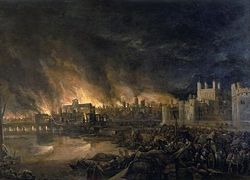
The unsanitary and overcrowded City of London has suffered from the numerous outbreaks of the plague many times over the centuries, but in Britain it is the last major outbreak which is remembered as the "Great Plague" It occurred in 1665 and 1666 and killed around 60,000 people, which was one fifth of the population.
The Great Fire of London broke out in the original City and quickly swept through London's wooden buildings, destroying large swathes of the city. The fire destroyed about 60 percent of the City, including Old St Paul's Cathedral, 87 parish churches, 44 livery company halls and the Royal Exchange. However the number of lives lost was surprisingly small; it is believed to have been 16 at most. Rebuilding took over 10 years largely under direction of a Commission appointed by King Charles II and chaired by Sir Christopher Wren, and followed the street plan of the old city.
The new City was different from the old one. Many aristocratic residents never returned, preferring to take new houses in the West End, where fashionable new districts such as St James's were built close to the main royal residence, which was Whitehall Palace until it was destroyed by fire in the 1690s, and thereafter St James's Palace.
The Revocation of the Edict of Nantes in 1685, led to a large migration on Huguenots to London. At this time the City of London was becoming the world's leading financial centre, superseding Amsterdam in primacy. The Bank of England was founded in 1694, and the British East India Company was expanding its influence. Lloyd's of London also began to operate in the late 17th century. In 1700 London handled 80 percent of England's imports, 69 percent of its exports and 86 percent of its re-exports.
Eighteenth century
The 18th century was a period of rapid growth for London, reflecting an increasing national population, the early stirrings of the Industrial Revolution, and London's role at the centre of the evolving British Empire. London spread beyond its traditional limits at an accelerating pace. New districts such as Mayfair were built for the rich in the West End, new bridges over the Thames encouraged an acceleration of development in South London and in the East End, the Port of London expanded downstream from the City. During this period was also the uprising of the American colonies.
Eighteenth century London was dogged by crime, the Bow Street Runners were established in 1750 as a professional police force. Penalties for crime were harsh, with the death penalty being applied for fairly minor crimes. Public hangings were common in London, and were popular public events.
In 1780 London was rocked by the Gordon Riots, an uprising by Protestants against Roman Catholic emancipation led by Lord George Gordon. Severe damage was caused to Catholic churches and homes, and 285 rioters were killed.
Up until 1750, London Bridge was the only crossing over the Thames, but in that year Westminster Bridge was opened and, for the first time in history, London Bridge, in a sense, had a rival.
Nineteenth century
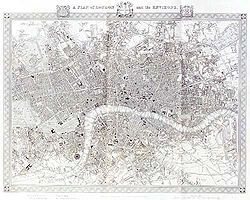
During the 19th century, London was transformed into the world's largest city and capital of the British Empire. Its population expanded from 1 million in 1800 to 6.7 million a century later. During this period, London became a global political, financial, and trading capital. In this position, it was largely unrivaled until the latter part of the century, when Paris and New York began to threaten its dominance.
While the city grew wealthy as Britain's holdings expanded, 19th century London was also a city of poverty, where millions lived in overcrowded and unsanitary slums. Life for the poor was immortalised by Charles Dickens in such novels as Oliver Twist.
In 1829, the prime minister Robert Peel established the Metropolitan Police as a police force covering the entire urban area. The force gained the nickname of "bobbies" or "peelers" named after Robert Peel.
Nineteenth century London was transformed by the coming of the railways. A new network of metropolitan railways allowed for the development of suburbs in neighboring counties from which middle-class and wealthy people could commute to the centre. While this spurred the massive outward growth of the city, the growth of greater London also exacerbated the class divide, as the wealthier classes emigrated to the suburbs, leaving the poor to inhabit the inner city areas.
As the capital of a massive empire, London became a magnet for immigrants from the colonies and poorer parts of Europe. A large Irish population settled in the city during the Victorian period, with many of the newcomers refugees from the Great Famine (1845-1849). At one point, Irish immigrants made up about 20% of London's population. London also became home to a sizable Jewish community, and small communities of Chinese and South Asians settled in the city.
The first railway to be built in London was a line from London Bridge to Greenwich, which opened in 1836. This was soon followed by the opening of great rail termini which linked London to every corner of Britain. These included Euston station (1837), Paddington station (1838), Fenchurch Street station (1841), Waterloo station (1848), King's Cross station (1850), and St Pancras station (1863). From 1863, the first lines of the London Underground were constructed.
One of the most famous events of 19th-century London was the Great Exhibition of 1851. Held at The Crystal Palace, the fair attracted visitors from across the world and displayed Britain at the height of its Imperial dominance.
Twentieth century
London entered the 20th century at the height of its influence as the capital of the largest empire in history, but the new century was to bring many challenges. London's population continued to grow rapidly in the early decades of the century, and public transport was greatly expanded. A large tram network was constructed by the London County Council, through the LCC Tramways. And the first motorbus service began in the 1900s. Improvements to London's overground and underground rail network, including large scale electrification were progressively carried out.
First World War
During World War I, London experienced its first bombing raids carried out by German zeppelin airships; these killed around 700 people and caused great terror, but were merely a foretaste of what was to come. The city of London would experience many more terrors as a result of both World Wars. The largest explosion in London occurred during World War I: the Silvertown explosion, when a munitions factory containing 50 tons of TNT exploded, killing 73 and injuring 400.
Like the rest of the country, London suffered severe unemployment during the Great Depression of the 1930s. In the East End during the 1930s, politically extreme parties of both right and left flourished. The Communist Party of Great Britain won a seat in the House of Commons, and the far-right British Union of Fascists received extensive support. Clashes between right and left culminated in the Battle of Cable Street in 1936. The population of London reached an all time peak of 8.6 million in 1939.
Large numbers of Jewish immigrants fleeing from Nazi Germany, settled in London during the 1930s, who settled mostly in the West End.
Second World War

During World War II, London, as many other British cities, suffered severe damage, being bombed extensively by the Luftwaffe as a part of The Blitz. Prior to the bombing, hundreds of thousands of children in London were evacuated to the countryside to avoid the bombing. Civilians took shelter from the air raids in underground stations.
The heaviest bombing took place between September, 1940, and May 10, 1941. During this period, London was subjected to 71 separate raids receiving over 18,000 tonnes of high explosive. Less intensive bombing followed over the following few years as Hitler concentrated on the Eastern front. Towards the end of the war, during 1944/45 London came under heavy attack again by pilotless V-1 and V-2 rockets, which were fired from Nazi occupied Europe.
London suffered severe damage and heavy casualties, the worst hit part being the Docklands area. By the war's end, just under 30,000 Londoners had been killed by the bombing, and over 50,000 seriously injured, tens of thousands of buildings were destroyed, and hundreds of thousands of people were made homeless.
Rebuilding
Immediately after the war, the 1948 Summer Olympics were held at the original Wembley Stadium, at a time when the city had barely recovered from the war. London's rebuilding was slow to begin. However, in 1951 the Festival of Britain was held, which marked an increasing mood of optimism and forward looking.
In the immediate postwar years housing was a major issue in London, due to the large amount of housing which had been destroyed in the war. The authorities decided upon high-rise blocks of flats as the answer to housing shortages. During the 1950s and 1960s the skyline of London altered dramatically as tower blocks were erected, although these later proved unpopular. In a bid to reduce the number of people living in overcrowded housing, a policy was introduced of encouraging people to move into newly built new towns surrounding London.
In the decades following World War II, large-scale immigration from Commonwealth countries and beyond transformed London into one of the most racially and culturally diverse cities in Europe. Integration of the new immigrants was not always smooth, with major race riots in Notting Hill and Brixton, but was certainly smoother than in other English regions and largely lacking in widespread support for far right organisations, unlike its European or American contemporaries.
An economic revival from the 1980s onwards re-established London's position as a pre-eminent international centre. However, as the seat of government and the most important city in the UK, it has been subjected to bouts of terrorism. Provisional Irish Republican Army bombers sought to pressure the government into negotiations over Northern Ireland, frequently disrupting city activities with bomb threats—some of which were carried out—until their 1997 cease-fire.
More recently, a series of coordinated bomb attacks were carried out by Islamic extremist suicide bombers on the public transport network on July 7, 2005, just 24 hours after London was awarded the 2012 Summer Olympics.
Government and politics
London is the home of the Government of the United Kingdom which is located around the Houses of Parliament in Westminster. Many government departments are located close to Parliament, particularly along Whitehall, including the Prime Minister's residence at 10 Downing Street.
The British Parliament is often referred to as the "Mother of Parliaments" (although this sobriquet was first applied to England itself by John Bright because it has been the model for most other parliamentary systems, and its Acts have created many other parliaments. Most countries in Europe and the Commonwealth have similarly organised parliaments with a largely ceremonial head of state who formally opens and closes parliament, a large elected lower house and a smaller, upper house.
London is represented in the national Parliament by 74 Members of Parliament (MPs) who correspond to local parliamentary constituencies. Of these 74 MPs, 44 are from the Labour Party, 21 are Conservatives, 8 are Liberal Democrats and one is from the RESPECT party.
The City has its own governance and boundaries, giving it a status as the only completely autonomous local authority in London.
The administration of London takes place in two tiers—a city-wide, strategic tier and a local tier. City-wide administration is coordinated by the Greater London Authority, while local administration is carried out by 33 smaller authorities. The Greater London Authority consists of two elected parts; the Mayor of London, who has executive powers, and the London Assembly, who scrutinise the mayor's decisions and can accept or reject his budget proposals each year. The Greater London Authority was set up in 2000 to replace the similar Greater London Council which had been abolished in 1986. The headquarters of the Greater London Authority and the Mayor of London is at City Hall; the mayor in 2008 was Boris Johnson. The 33 local authorities are the councils of the 32 London boroughs and the City of London Corporation. They are responsible for local services not overseen by the Greater London Authority, such as local planning, schools, social services, local roads and refuse collection.
Economy
London is one of three "command centres" for the world economy (along with New York City and Tokyo). London is one of the largest centres for finance in the world, and has the sixth largest city economy in the world after Tokyo, New York, Los Angeles, Chicago and Paris. London generates approximately 20 percent of the UK's GDP (or $446 billion in 2005); while the economy of the London metropolitan area (the largest in Europe) generates approximately 30 percent of UK's GDP (or an estimated $669-billion in 2005.)
Financial and business services sector accounts for about 85 per cent of London’s employment. London’s banking sector accounts for about 20 per cent of total international bank lending. London has one of the largest international insurance markets, the world’s largest centre for trading overseas equities, the largest foreign exchange market, one of the biggest financial derivatives markets, the greatest concentration of international bond dealers, and major markets for transactions in commodities. London also has a vast range of legal, accountancy, management, property, computer, and advertising consultancy services.
A second, smaller financial district is developing at Canary Wharf to the east of the City which includes the global headquarters of HSBC, Reuters, Barclays and the Magic Circle, which includes Clifford Chance, the largest law firm in the world.
London's success is as a service industry and business centre can be attributed to English being the lingua franca, its former position as the capital of the British Empire, close relationship with the U.S. and various countries in Asia. Other factors include English law being the most important and most used contract law in international business and the multi-cultural infrastructure. Government policies such as low taxes, particularly for foreigners (non-UK domiciled residents do not get taxed on their foreign earnings), a business friendly environment, good transport infrastructure, particularly its aviation industry; and a deregulated economy with little intervention by the government have all contributed to London's economy becoming more service based.
Tourism is one of London's prime industries, and employed the equivalent of 350,000 full-time workers in London in 2003. Annual expenditure by tourists is around £15-billion, and overseas visitors accounted for 70 per cent of this spending. London has about 480 hotels. The most popular attractions are the British Museum (five million visitors in 2001), the National Gallery, Westminster Abbey (where the sovereign is crowned), Madame Tussaud’s waxworks, the London Eye (a giant Ferris wheel near Westminster Bridge), and the Tower of London.
Another half a million employees resident in Greater London work in manufacturing and construction, almost equally divided between both. Heavy industry has declined since World War II, and between 1982 and 1994 the numbers employed in manufacturing almost halved to approximately 328,000. Printing and publishing accounts for over a quarter of London’s manufacturing employment, eflecting London’s role as an administrative, financial, and media centre. Other sectors include electrical and electronic engineering; food, drink, and tobacco; and chemicals and synthetic fibres. There is strong growth in the recycling/environmental sector.
The centrepiece of the public transport network is the London Underground—commonly referred to as The Tube—which has eleven interconnecting lines. It is the oldest, longest, and most expansive metro system in the world, dating from 1863. The Docklands Light Railway is a second metro system using smaller and lighter trains, which opened in 1987, serving East London and Greenwich on both sides of the Thames.
High-speed Eurostar trains link St Pancras International with Lille and Paris in France, and Brussels in Belgium. Journey times to Paris and Brussels of 2h 15 and 1h 51 respectively make London closer to continental Europe than the rest of Britain by virtue of the newly-completed High Speed 1 rail link to the Channel Tunnel.<
London's bus network is one of the biggest in the world, running 24 hours, with 8000 buses, 700 bus routes, and over 6 million passenger journeys made every weekday. In 2003, the network's ridership was estimated at over 1.5 billion passenger trips per annum which is more than the Underground.
Although the majority of journeys involving central London are made by public transport, travel in outer London is car-dominated. The inner ring road (around the city centre), the North and South Circular roads (in the suburbs), and the outer orbital motorway (the M25, outside the built-up area) encircle the city and are intersected by a number of busy radial routes—but very few motorways penetrate into inner London. In 2003, a congestion charge was introduced to reduce traffic volumes in the city centre. With a few exceptions, motorists are required to pay £8 per day to drive within a defined zone encompassing much of congested central London.
London is a major international air transport hub. No fewer than eight airports use the words London Airport in their name, but most traffic passes through one of five major airports. London Heathrow Airport is the busiest airport in the world for international traffic, and is the major hub of the nation's flag carrier, British Airways.
From being the largest port in the world, the Port of London is now only the third-largest in the United Kingdom, handling 50 million tonnes of cargo each year.
Demography
With increasing industrialisation, London's population grew rapidly throughout the 19th and early 20th centuries, and it was the most populated city in the world until overtaken by New York in 1925. Its population peaked at 8,615,245 in 1939. There were an estimated 7,512,400 official residents in Greater London as of mid-2006.[2] However, London's continuous urban area extends beyond the borders of Greater London and was home to 8,278,251 people in 2001,[3] while its wider metropolitan area has a population of between 12 and 14 million depending on the definition of that area.[7] According to Eurostat, London is the most populous city and metropolitan area of the European Union and the second most populous in Europe (or third if Istanbul is considered European).
| Country of Birth | Population (2001) |
|---|---|
| 5,230,155 | |
| 172,162 | |
| 157,285 | |
| 120,900 | |
| 84,565 | |
| 80,319 | |
| 68,907 | |
| 66,311 | |
| 49,932 | |
| 46,513 | |
| 45,888 | |
| 45,506 | |
| 44,622 | |
| 41,488 | |
| 39,818 | |
| 39,128 | |
| 38,694 | |
| 38,130 | |
| 33,831 | |
| 32,082 | |
| 27,494 |
The region covers an area of 609 square miles (1,579 km²). The population density is 12,331 people per square mile (4,761/km²), more than ten times that of any other British region. In terms of population, London is the 25th largest city and the 17th largest metropolitan region in the world. It is also ranked 4th in the world in number of billionaires (United States Dollars) residing in the city.[8] London ranks as one of the most expensive cities in the world, alongside Tokyo and Moscow.[9]
Ethnic groups
According to 2005 estimates[2], 69.6% of these seven and a half million people are classed as white, including White British (58.2%), White Irish (2.6%) and "Other White" (8.8%), the majority of whom are other Europeans. 12.9% of people are of South Asian descent, including Indian, Pakistani, Bangladeshi and "Other Asian" (mostly Sri Lankan, Arab and other Southern Asian ethnicities). 10.8% of people are Black (around 5.5% are Black African, 4.4% as Black Caribbean, 0.8% as "Other Black"). 3.4% are of mixed race; 1.4% are Chinese; and 1.9% of people belong to another ethnic group (mostly Latin American - an estimated 60,000 Brazilians reside in London,[10] Filipino, Japanese, Korean, Vietnamese and other East Asians). 21.8% of inhabitants were born outside the European Union. The Irish born, from both the Republic of Ireland and Northern Ireland, number approximately 250,000 and are the largest group born outside of Britain.

In January 2005, a survey of London's ethnic and religious diversity claimed that there were more than 300 languages spoken and more than 50 non-indigenous communities which have a population of more than 10,000 in London.[11] Figures from the Office for National Statistics show that, as of 2006, London's foreign-born population is 2,288,000 (31%), up from 1,630,000 in 1997.[12] The 2001 census showed that 27.1% of Greater London's population were born outside the UK, and a slightly higher proportion were classed as non-white.[13]
The table to the right shows the 'Country of Birth' of London residents in 2001, the date of the last UK Census. (Top 21).[14] Note that a portion of the German-born population are likely to be British nationals born to parents serving in the British armed forces in Germany.[15]
As of 2008, 40% of London's total population is from an ethnic minority group.[16] Across London, Black and Asian children outnumber White British children by about six to four.[17]
Religion

The largest religious groupings in London are Christian (57.8%), No Religion (15.5%), Muslim (7.9%), Hindu (4.1%), Jewish (3.1%), and Sikh (1.5%).[citation needed] London has traditionally been dominated by Christianity, and has a large number of churches, particularly in the City. The well-known St Paul's Cathedral in the City and Southwark Cathedral south of the river are Anglican administrative centres,[18] while the principle bishop of the Church of England and worldwide Anglican Communion, the Archbishop of Canterbury has his main residence at Lambeth Palace in the London Borough of Lambeth.[19] Important national and royal ceremonies are shared between St Paul's and Westminster Abbey.[20] The Abbey is not to be confused with nearby Westminster Cathedral, which is the largest Roman Catholic cathedral in England and Wales.[21] Religious practice is lower than any other part of the UK or Western Europe and is around seven times lower than American averages.[22] Despite the prevalence of Anglican churches, observance is very low within the Anglican denomination, although church attendance, particularly at evangelical Anglican churches in London, has started to increase.[23]
London is also home to sizeable Muslim, Hindu, Sikh, and Jewish communities. Many Muslims live in Tower Hamlets and Newham; the most important Muslim edifice is London Central Mosque on the edge of Regent's Park.[24] London's large Hindu community is found in the north-western boroughs of Harrow and Brent, the latter of which is home to one of Europe's largest Hindu temples, Neasden Temple.[25] Sikh communities are located in East and West London, which is also home to the largest Sikh temple in the world, outside India.[26] The majority of British Jews live in London, with significant Jewish communities in Stamford Hill, St. John's Wood, Golders Green, and Edgware in North London.[27]
Education
Home to a range of universities, colleges and schools, London has a student population of about 378,000.[28] and is a centre of research and development. Most primary and secondary schools in London follow the same system as the rest of England.
With 125,000 students, the University of London is the largest contact teaching university in the United Kingdom and in Europe.[29] It comprises 20 colleges as well as several smaller institutes, each with a high degree of autonomy. Constituent colleges have their own admissions procedures, and are effectively universities in their own right, although most degrees are awarded by the University of London rather than the individual colleges. Its constituents include multi-disciplinary colleges such as UCL,[30] King's[31] and Royal Holloway[32] and more specialised institutions such as the London School of Economics,[33] SOAS,[34] the Royal Academy of Music[35] and the Institute of Education.[36]
Imperial College London and UCL have been ranked among the top ten universities in the world by The Times Higher Education Supplement: in 2007 Imperial was ranked the 5th best and UCL the 9th best university in the world.[37]
In addition, the LSE is considered the world‘s leading social science institution for teaching and research, plus has the most international student body of any university in the world today.[38]
London's other universities, such as Brunel University, City University, London Metropolitan University, Imperial College London, Middlesex University, University of East London, the University of Westminster and London South Bank University are not part of the University of London but still leaders in their field and popular choices among students both nationally and internationally. Some were polytechnics until these were granted university status in 1992, and others which were founded much earlier. Imperial College London left the University of London in 2007. London is also known globally for its business education, with the London Business School (ranked 1st in Europe - Business Week)[39][40] and Cass Business School (Europe's largest finance school) both being top world-rated business schools.[41] In addition there are three international universities: Schiller International University, Richmond University and Regent's College.
London is also a world leader in the creative industries and the University of the Arts London is a recognised university that specialises in all forms of the arts and was listed in Business Week's D-School list[42]. The only other British arts institute listed was the Royal College of Art.
London is home to many museums, galleries, and other institutions which are major tourist attractions as well as playing a research role. The Natural History Museum (biology and geology), Science Museum and Victoria and Albert Museum (fashion and design) are clustered in South Kensington's "museum quarter", while the British Museum houses historic artefacts from around the world.[43] The British Library at St Pancras is the UK's national library, housing 150 million items.[44] The city also houses extensive art collections, primarily in the National Gallery,[45] Tate Britain[46] and Tate Modern.[47] See the list of museums in London.
Society and culture
Landmarks
Architecture
London is too diverse to be characterised by any particular architectural style, having accumulated its buildings over a long period of time and drawn on a wide range of influences. It is, however, mainly brick built, most commonly the yellow London stock brick or a warm orange-red variety, often decorated with carvings and white plaster mouldings.[48] Many grand houses and public buildings (such as the National Gallery) are constructed from Portland stone.[49] Some areas of the city, particularly those just west of the centre, are characterised by white stucco or whitewashed buildings. Few structures pre-date the Great Fire of 1666, except for a few trace Roman remains, the Tower of London and a few scattered Tudor survivors in the City. A majority of buildings in London date from the Edwardian or Victorian periods.[48] The disused (but soon to be rejuvenated) 1939 Battersea Power Station by the river in the south-west is a local landmark,[50] while some railway termini are excellent examples of Victorian architecture, most notably St Pancras and Paddington (at least internally).[51]
The density of London varies, with high employment density in the central area, high residential densities in inner London and lower densities in the suburbs. In the dense areas, most of the concentration is achieved with medium-rise and high-rise buildings. London's skyscrapers such as the notable "Gherkin", Tower 42 and One Canada Square are usually found in the two financial districts, the City of London and Canary Wharf.[52][53][54] Other notable modern buildings include City Hall in Southwark with its distinctive oval shape,[55] the British Library in Somers Town/Kings Cross,[56] and the Great Court of the British Museum.[57] What was formerly the Millennium Dome, located by the Thames to the east of Canary Wharf, is now used as an entertainment venue known as The O2.[58]
The development of tall buildings has been encouraged in the London Plan, which will lead to the erection of many new skyscrapers over the next decade, particularly in the City of London and Canary Wharf.[59] The 72-storey, 1,017 feet (310 m) "Shard London Bridge" by London Bridge station,[60] the 945 feet (288 m) Bishopsgate Tower and around 20 other skyscrapers over 500 feet (150 m) are either proposed or approved and could transform the city's skyline.[61]
A great many monuments pay homage to people and events in the city. The Monument in the City of London provides views of the surrounding area while commemorating the Great Fire of London, which originated nearby.[62] Marble Arch and Wellington Arch, at the north and south ends of Park Lane respectively, have royal connections, as do the Albert Memorial and Royal Albert Hall in Kensington.[63] Nelson's Column is a nationally-recognised monument in Trafalgar Square, one of the focal points of the centre.[64]
Parks and gardens
Often called "The Green City," London has a number of open spaces.[65] The largest of these in the central area are the Royal Parks of Hyde Park and its neighbour Kensington Gardens at the western edge of central London and Regent's Park on the northern edge.[66] This park is located near the tourist attractions of Baker Street, where the fictional Sherlock Holmes lived,[67] and Madame Tussauds Wax Museum.[68][69] Closer to central London are the smaller Royal Parks of Green Park and St. James's Park.[70] Hyde Park in particular is popular for sports and sometimes hosts open-air concerts.
A number of large parks lie outside the city centre, including the remaining Royal Parks of Greenwich Park to the south-east,[71] Bushy Park and Richmond Park to the south-west[72][73] and Victoria Park, East London to the east.[74] Primrose Hill to the north of Regent's Park is a popular spot to view the city skyline.[75][76] Some more informal, semi-natural open spaces also exist, including the 791-acre (3.2 km²) Hampstead Heath of North London.[77]This incorporates Kenwood House, the former stately home and a popular location in the summer months where classical music concerts are held by the lake, attracting thousands of people every weekend to enjoy the music, scenery and fireworks.[78]In the extreme South East of Greater London, the London Boroughs of Bexley and Bromley are noted for their open spaces and extensive wooded areas.[79]
Leisure and entertainment
Within the City of Westminster, the entertainment district of the West End has its focus around Leicester Square, where London and world film premieres are held, and Piccadilly Circus, with its giant electronic advertisements.[80] London's theatre district is here, as are many cinemas, bars, clubs and restaurants, including the city's Chinatown district, and just to the east is Covent Garden, an area housing speciality shops. Shoreditch and Hoxton in the East End contain a plethora of bars, nightclubs, restaurants and galleries.[80] Islington's one mile (2 km) long Upper Street, extending northwards from The Angel, has more bars and restaurants than any other street in the UK.
Europe's busiest shopping area is Oxford Street, a shopping street nearly one mile (2 km) long—which makes it the longest shopping street in the world—and home to many shops and department stores including Selfridges.[80] The adjoining Bond Street in Mayfair is an extremely upmarket location, home to fashion, jewellery, and accessories design houses.[80] Knightsbridge—home to the Harrods department store— lies just to the southwest. Together with these, the fashionable shopping areas of Sloane Street, and Kings Road represent London's prestigious role in the world of fashion. London is home to Vivienne Westwood, Galliano, Stella McCartney, Manolo Blahnik, and Jimmy Choo among others; its renowned art and fashion schools make it an international centre of fashion alongside Paris, Milan and New York.[80] London also has a high number of street markets, including Camden Market for fashions and alternative products, Portobello Road for antiques, and vintage and one-off clothes, and Borough Market for organic and specialist foods.[80] London is known for its varying and outstanding cuisine and variety of restaurants, the London and British press are often used by Londoners (more than tourists) to gauge the quality of new restaurants. Publications such as Time Out, Lusso Magazine, and Square Meal contain multiple restaurant reviews each issue. Some acclaimed restaurants include Gaucho, Momos, Kensington Roof Gardens, OXO Tower, the Mandarin Oriental's restaurant, Palm Beach, Lincontro and the Mango Tree.[81]
London offers a great variety of cuisine as a result of its ethnically diverse population. Gastronomic centres include the Bangladeshi restaurants of Brick Lane and the Chinese food restaurants of Chinatown.[82]Soho's variety of restaurants includes Italian- and Greek-influenced establishments among others, as well as all manner of novelties and oddities. More upmarket restaurants are scattered around central London, with concentrations in Mayfair, Knightsbridge and Notting Hill. Across the city, areas home to particular ethnic groups are often recognizable by restaurants, food shops and market stalls offering their local fare, and the large supermarket chains stock such items in areas with sizable ethnic groups.
There are a variety of regular annual events. The Caribbean-descended community in Notting Hill in West London organizes the colourful Notting Hill Carnival, Europe's biggest street carnival, every summer.[83]The beginning of the year is celebrated with the relatively new New Year's Day Parade, while traditional parades include November's Lord Mayor's Show, a centuries-old event celebrating the annual appointment of a new Lord Mayor of the City of London with a procession along the streets of the City, and June's Trooping the Colour, a very formal military pageant to celebrate the Queen's Official Birthday.[80]
Literature and film
London has been the setting for many works of literature. Two writers closely associated with the city are the diarist Samuel Pepys, noted for his eyewitness account of the Great Fire, and Charles Dickens, whose representation of a foggy, snowy, grimy London of street sweepers and pickpockets has been a major influence on people's vision of early Victorian London.[84] James Boswell's biographical Life of Johnson mostly takes place in London, and is the source of Johnson's well-known aphorism: "When a man is tired of London, he is tired of life; for there is in London all that life can afford." The earlier (1722) A Journal of the Plague Year by Daniel Defoe is a fictionalisation of the events of the 1665 Great Plague.[84] William Shakespeare spent a large part of his life living and working in London; his contemporary Ben Jonson was also based in London, and some of his work - most notably his play The Alchemist - was set in the city.[84] Later important depictions of London from the 19th and early 20th centuries are the afore-mentioned Dickens novels, and Arthur Conan Doyle's illustrious Sherlock Holmes stories.[84] Trollope's Palliser novels are largely set in London, vividly depicting Westminster and its surrounds. The 1933 novel Down and Out in Paris and London by George Orwell describes life in poverty in both cities.[84] A modern writer pervasively influenced by the city is Peter Ackroyd, in works such as London: The Biography, The Lambs of London and Hawksmoor. Academic Bloomsbury and hilly Hampstead have traditionally been the liberal, literary heartlands of the city.
London has played a significant role in the film industry, and has major studios at Pinewood, Shepperton, Elstree and Leavesden, as well as an important special effects and post-production community centred in Soho in central London. Working Title Films has its headquarters in London.[85]Many films have also used London as a location and have done much to shape international perceptions of the city. See main article London in film.
The city also hosts a number of performing arts schools, including the Central School of Speech and Drama (alumni: Judi Dench and Laurence Olivier), the London Academy of Music and Dramatic Art (alumni: Jim Broadbent and Donald Sutherland) and the prestigious Royal Academy of Dramatic Art (alumni: Joan Collins and Roger Moore). The London Film Festival is held each year in October.[86]
Music
London is one of the major classical and popular music capitals of the world and is home to major music corporations, such as EMI and Decca Records, as well as countless bands, musicians and industry professionals.
London is home to many orchestras and concert halls such as the Barbican Arts Centre (principal base of the London Symphony Orchestra), Cadogan Hall (Royal Philharmonic Orchestra), the Royal Albert Hall (BBC Promenade Concerts), the Royal Festival Hall (Philharmonia Orchestra, London Philharmonic Orchestra, London Sinfonietta) and Wigmore Hall.[87] London's two main opera houses are the Royal Opera House and the Coliseum Theatre.[87] The United Kingdom's Royal Ballet and the English National Ballet are based in London and perform at the Royal Opera House, the Coliseum, Sadler's Wells Theatre and the Royal Albert Hall.[87]
As a cultural centre for the United Kingdom, London has had a major role in many popular music movements. It has numerous renowned venues for rock and pop concerts, including large arenas such as Earls Court and Wembley Arena, as well as more intimate venues, such as Brixton Academy and Hammersmith Apollo.[87] The area around the northern part of Charing Cross Road in Westminster is well known for its shops that sell modern musical instruments and audio equipment. London was home of one of the legs for both the Live Aid and Live 8 concerts.
London and its surrounding Home Counties have spawned iconic and popular artists. London is home to the first and original Hard Rock Cafe and the illustrious Abbey Road Studios where The Beatles created many of their hits. Musicians such as Bob Marley, Jimi Hendrix and Freddie Mercury have lived in London.[88] Notable musicians and groups associated with London include The Who, Fleetwood Mac, Iron Maiden, Elton John, Elvis Costello, Cliff Richard, John Lennon, Queen, Yoko Ono, Paul McCartney, Pink Floyd, Led Zeppelin and The Rolling Stones. London was instrumental in the development of punk music, with figures such as the Sex Pistols, The Clash, The Jam, and Vivienne Westwood all based in the city.
As Britain's largest urban area, London has played a key role in the development of most British-born strains of "urban" and electronic music, such as drum and bass, UK garage, grime and dubstep, and is home to many UK hip hop artists.
The largest entertainment venture of all time, The Phantom of the Opera, a musical by Andrew Lloyd Webber, premiered here at Her Majesty's Theatre, and emerged as the highest grossing entertainment event with US $3.3 billion, and attendance of 80 million worldwide.
Sport
London has hosted the Summer Olympics twice, in 1908 and 1948.[90][91] In July 2005 London was chosen to host the Games in 2012, which will make it the first city in the world to host the Summer Olympics three times.[92] London was also the host of the British Empire Games in 1934.[93]
London's most popular sport (for both participants and spectators) is football.[94] London has thirteen League football clubs, including five in the Premier League ( Chelsea, Arsenal, Fulham, Tottenham Hotspur and West Ham United ),[95] plus a further eight in the remaining three divisions (Barnet, Brentford, Charlton Athletic, Crystal Palace, Dagenham & Redbridge, Leyton Orient, Millwall and Queens Park Rangers), plus countless non-league and amateur football teams.
London has a special place in the history of Association Football.[96] The playing of football in London has been well documented since it was first outlawed in 1314. In the sixteenth century the headmaster of St Paul's School, Richard Mulcaster is credited with taking mob football and transforming it into organised and refereed team football.[97] The modern game of football was first codified in 1863 in London and subsequently spread worldwide.[98] Key to the establishment of the modern game was Londoner Ebenezer Cobb Morley who was a founding member of the Football Association, the oldest football organisation in the world.[99]Morley wrote to Bell's Life newspaper proposing a governing body for football which led directly to the first meeting at the Freemason's Tavern in central London of the FA.[99] He wrote the first set of rules of true modern football at his house in Barnes.[99] The modern passing game was invented in London in the early 1870s by the Royal Engineers A.F.C.[100][101]
London also has four rugby union teams in the Guinness Premiership (London Irish, Saracens, Wasps and Harlequins), although only the Harlequins play in London (all the other three now play outside Greater London).[102] London also has many other rugby union clubs in lower leagues, including Richmond F.C., Blackheath R.C., Rosslyn Park F.C. and Barnes R.F.C.
London has its own rugby league Super League club in Harlequins RL and the National League Two team the London Skolars as well as a thriving amateur scene.[103]
Since 1924, the original Wembley Stadium was the home of the English national football team, and served as the venue for the FA Cup final as well as rugby league's Challenge Cup final.[104]The new Wembley Stadium serves exactly the same purposes. Twickenham Stadium in west London is the national rugby union stadium, and has a capacity of 84,000 now that the new south stand has been completed.[105]
Basketball in London has seen many powerful teams succumb to financial difficulties and disappear without a trace. London Towers are the most recognisable name to experience the rise and fall,[106] and are joined by Greater London Leopards and, in 2007, London United.[107] The capital's only representative in the top-tier British Basketball League is newly elected London Capital, who boast former Los Angeles Lakers star Steve Bucknall as their coach.[108] They play their home games at Capital City Academy, although rumours abound suggest a future move to Wembley Arena, along with the return of the Towers to the planned Croydon Arena.
Cricket in London centres on its two Test cricket grounds at Lord's (home of Middlesex C.C.C) in St John's Wood,[109] and The Oval (home of Surrey C.C.C) in Kennington.[110] One of London's best-known annual sports competitions is the Wimbledon Tennis Championships, held at the All England Club in the south-western suburb of Wimbledon.[111]Other key events are the annual mass-participation London Marathon which sees some 35,000 runners attempt a 26.2 mile (~42 km) course around the city,[112] and the Oxford vs. Cambridge Boat Race on the River Thames between Putney and Mortlake.[113]
See also
- Greater London
- Large Cities Climate Leadership Group
- List of songs about London
- London Design Festival
- London markets
- London slang
- Megacity
- Squares in London
- Subterranean London
- Tallest landmarks in London
Further reading
- Ackroyd, Peter (2001). London: The Biography. London: Vintage, 880. ISBN 0099422581.
- Reddaway, Thomas Fiddian (1940). The Rebuilding of London After the Great Fire. Jonathan Cape, 333.
- Aubin, Robert Arnold (1943). London in flames, London in glory: poems on the fire and rebuilding of London. Rutgers University Press, 383.
ReferencesISBN links support NWE through referral fees
- ↑ London, United Kingdom Forecast : Weather Underground (weather and elevation at Heathrow Airport) (online). The Weather Underground, Inc.. Retrieved 2007-03-16.
- ↑ 2.0 2.1 T 08: Selected age groups for local authorities in the United Kingdom; estimated resident population; Mid-2006 Population Estimates (XLS). Office for National Statistics (August 22, 2007). Retrieved 2007-08-22.
- ↑ 3.0 3.1 KS01 Usual resident population: Census 2001, Key Statistics for urban areas www.statistics.gov.uk
- ↑ World Gazetteer - World: metropolitan areas
- ↑ London Metropolitan Area population. Demographia (August 28, 2007). Retrieved 2007-08-27.
- ↑ Neighbourhood Statistics. Neighbourhood Statisics. Retrieved 2008-04-29.
- ↑ South-east England Population by Area from 1891. Demographia. Retrieved 2007-08-09.
- ↑ Forbes Magazine list of billionaires.. Forbes. Retrieved 2007-10-08.
- ↑ CNN Money World's Most Expensive Cities 2004.. CNN. Retrieved 2007-08-16.
- ↑ BBC - London - Faith - Brazilian London. British Broadcasting Corporation. Retrieved 2008-04-29.
- ↑ London: Every race, colour, nation and religion on earth. The Guardian. Retrieved 2008-05-06.
- ↑ One Third of Londoners born outside Britain. This is London. Retrieved 2006-12-21.
- ↑ "Census 2001: London", Office for National Statistics. Retrieved on 2006-06-03.
- ↑ Greater London Authority - Summary of 'Country-of-Birth' in London. Greater London Authority. Retrieved 2006-12-21.
- ↑ Sarah Kyambi, Beyond Black and White: Mapping new immigrant communities, London: Institute for Public Policy Research, 7 September 2005. Retrieved on 2007-01-20.
- ↑ London's black and minority communities helped to have a greater voice by London Councils. londoncouncils.gov.uk
- ↑ Graeme Paton (2007-10-01). One fifth of children from ethnic minorities. The Daily Telegraph. Retrieved 2008-03-28.
- ↑ About Saint Paul's Cathedral. Dean and Chapter St Paul's. Retrieved 2008-04-27.
- ↑ Lambeth Palace Library. Lambeth Palace Library. Retrieved 2008-04-27.
- ↑ Westminster Abbey. Dean and Chapter of Westminster. Retrieved 2008-04-27.
- ↑ West Minster Cathedral. Westminster Cathedral. Retrieved 2008-04-27.
- ↑ "Thousands of churches face closure in ten years’", Times Online, 2007-02-10. Retrieved 2007-08-16.
- ↑ Church of England Statistics. Church of England. Retrieved 2007-08-16.
- ↑ London Central Mosque Trust Ltd. London Central Mosque Trust Ltd. & The Islamic Cultural Centre. Retrieved 2008-04-27.
- ↑ "Hindu London", BBC, 6 June 2005. Retrieved on 2006-06-03.
- ↑ £17 m Sikh temple opens. British Broadcasting Corporation (30 March, 2003). Retrieved 2008-04-27.
- ↑ "Jewish Communities in London", British Broadcasting Corporation, 1 March 2006. Retrieved on 2006-06-03.
- ↑ "About the London Sector", London Higher Retrieved on 2006-06-03.
- ↑ "About the University", University of London, 2006-02-20. Retrieved on 2006-06-03.
- ↑ UCL - Jurisdiction over Students. University College London (7 November, 2005). Retrieved 2008-04-28.
- ↑ Queer discipline Spring 2008. King's College London (21 January, 2008). Retrieved 2008-04-28.
- ↑ Academic leadership - Royal Holloway. London External (31 October, 2007). Retrieved 2008-04-28.
- ↑ London School of Economics and Political Science. London School of Economics accessdate=2008-04-28.
- ↑ The School of Oriental and African Studies. School of Oriental and African Studies. Retrieved 2008-04-28.
- ↑ Quality Assessment Report by the HEFCE for the Royal Academy of Music. Royal Academy of Music. Retrieved 2008-04-28.
- ↑ Institute of Education - University of London. Institute of Education. Retrieved 2008-04-28.
- ↑ "Why 4/10 is a great score for Britain's universities". Retrieved on 2007-11-08.
- ↑ The Sunday Times Good University Guide 2007 - Profile for London School of Economics. Times Online. Retrieved 2007-05-08.
- ↑ About EBS London. Regent's College (2007). Retrieved 2008-04-28.
- ↑ Business Week. Business Week. Retrieved 2008-04-28.
- ↑ Cass Business School. Cass Business School (2007). Retrieved 2008-04-28.
- ↑ D- Schools List. Business Week (2007). Retrieved 2008-03-11.
- ↑ South Kensington - Museum Quarter. Travel Webshots. Retrieved 2008-04-28.
- ↑ "Some facts and figures", British Library. Retrieved on 2006-06-03.
- ↑ The National Gallery, London - Official Website. The Natinoal Gallery. Retrieved 2008-04-28.
- ↑ Tate Britain: British Art from 1500. Tate Britain. Retrieved 2008-04-28.
- ↑ Tate Modern: International modern and contemporary art. Tate Modern. Retrieved 2008-04-28.
- ↑ 48.0 48.1 London: architecture.. Retrieved 2007-08-16. Cite error: Invalid
<ref>tag; name "London Architecture" defined multiple times with different content - ↑ National Gallery: Trafalgar Square. Artefaqs Corporation. (2008). Retrieved 2008-04-27.
- ↑ Battersea Power Station. Artefaqs Corporation. (2008). Retrieved 2008-04-27.
- ↑ Paddington Station.. Great Buildings. Retrieved 2007-08-16.
- ↑ 30 Saint Mary Axe. Artefaqs Corporation. (2008). Retrieved 2008-04-26.
- ↑ Tower 42 - London Architecture. Artefaqs Corporation. (2008). Retrieved 2008-04-26.
- ↑ 1 Canada Square. Artefaqs Corporation. (2008). Retrieved 2008-04-26.
- ↑ Inside London's new 'glass egg'. British Broadcasting Corporation (Tuesday, 16 July, 2002). Retrieved 2008-04-26.
- ↑ The British Library. Artefaqs Corporation. (2008). Retrieved 2008-04-27.
- ↑ The British Museum. Artefaqs Corporation. (2008). Retrieved 2008-04-27.
- ↑ Millennium Dome. Artefaqs Corporation. (2008). Retrieved 2008-04-26.
- ↑ London - Full Summary of Projects. Will Fox, SkyscraperCity.com. Retrieved 2006-12-15.
- ↑ Shard London Bridge - Official Website. Shard London Bridge. Retrieved 2008-04-27.
- ↑ The Bishopsgate Tower. Skyscrapernews.com. Retrieved 2008-04-27.
- ↑ The Monument: Cannon Street. Artefaqs Corporation. (2008). Retrieved 2008-04-27.
- ↑ Royal Albert Hall: Kensington Gore. Artefaqs Corporation. (2008). Retrieved 2008-04-26.
- ↑ Nelson's Column, Trafalgar Square. Artefaqs Corporation. (2008). Retrieved 2008-04-26.
- ↑ [1] Green City Walks in London. Retrieved on 2007-08-17.
- ↑ Kensington Gardens. The Royal Parks (2008). Retrieved 2008-04-26.
- ↑ The Sherlocks Homes Museum. Sherlock Homes Museum. Retrieved 2008-04-26.
- ↑ Madame Tussauds - Official Website. Madame Tussauds. Retrieved 2008-04-26.
- ↑ Madame Tussauds - Tourist Information. Tourist Information UK. Retrieved 2008-04-26.
- ↑ Green Park. The Royal Parks (2008). Retrieved 2008-04-26.
- ↑ Greenwich Park. The Royal Parks (2008). Retrieved 2008-04-26.
- ↑ Bushy Park. The Royal Parks (2008). Retrieved 2008-04-26.
- ↑ Richmond Park. The Royal Parks (2008). Retrieved 2008-04-26.
- ↑ LondonTown - Victoria Park. LondonTown.com. Retrieved 2008-04-26.
- ↑ LondonTown - Primrose Hill. LondonTown.com. Retrieved 2008-04-26.
- ↑ Primrose Hill - Official Website. Technology News Ltd. Retrieved 2008-04-26.
- ↑ Hampstead Heath - City Of London. David Bentley (24 April, 2008). Retrieved 2008-04-26.
- ↑ Kenwood House. English Heritage. Retrieved 2008-04-26.
- ↑ London Borough of Bexley - Parks and Open Spaces. London Borough of Bexley. Retrieved 2008-05-06.
- ↑ 80.0 80.1 80.2 80.3 80.4 80.5 80.6 History and general information. Retrieved on 2007-08-17.
- ↑ Review from Lusso Magazine. Retrieved on 2008-03-21
- ↑ Chinatown - Official Website. Chinatown London. Retrieved 2008-04-27.
- ↑ London Town - Notting Hill Carnival. LondonTown.com. Retrieved 2008-04-27.
- ↑ 84.0 84.1 84.2 84.3 84.4 London in Literature.. Bryn Mawr College. Retrieved 2007-08-17.
- ↑ Working Title Films. Universal Studios. Retrieved 2008-04-27.
- ↑ The Times BFI. The Times BFI. Retrieved 2008-04-27.
- ↑ 87.0 87.1 87.2 87.3 Theatres and concert halls.. Your London. Retrieved 2007-08-17.
- ↑ Guide to England’s music history 'Chris'; Bootsn AllTravel Network; February 6 2007. Retrieved on 2007-05-30.
- ↑ "Wembley kick-off: Stadium is ready and England play first game in fortnight", Daily Mail, 2007-03-09. Retrieved 2007-03-19.
- ↑ Info Please - 1908 Summer Olympics. Pearson Education, Inc. Retrieved 2008-04-27.
- ↑ Info Please - 1948 Summer Olympics. Pearson Education, Inc. Retrieved 2008-04-27.
- ↑ "IOC elects London as the Host City of the Games of the XXX Olympiad in 2012", International Olympic Committee, 6 July 2005. Retrieved on 2006-06-03.
- ↑ British Empire Games Website. All Starts Flag. Retrieved 2008-04-27.
- ↑ (from London), Encyclopædia Britannica. Retrieved on 2006-06-14.
- ↑ TheFA.com - Premier League. The FA.com (17 January, 2004). Retrieved 2008-04-29.
- ↑ History of the FA. Football Association website. Retrieved 2007-10-09.
- ↑ Richard Mulcaster. Football Neywork. Retrieved 2008-04-29.
- ↑ Middleton Cambridge Football. Middleton Soccer. Retrieved 2008-04-29.
- ↑ 99.0 99.1 99.2 Football Association. Sparacus School. Retrieved 2008-04-29.
- ↑ Wall, Frederick (2005). 50 Years of Football, 1884–1934. Soccer Books Limited. ISBN 1-8622-3116-8. OCLC 56644992.
- ↑ The Encyclopedia of British Football.. Spartacus.schoolnet.co.uk. Retrieved 2007-08-16.
- ↑ Guinness Premiership: Clubs. Guinness Premiership (Premier Rugby). Retrieved 2008-04-29.
- ↑ Harlequins Rugby - Official Site. Harlequins Rugby. Retrieved 2008-04-29.
- ↑ Wembley Stadium History - Official Website. Wembley National Stadium Limited.. Retrieved 2008-04-29.
- ↑ RFU apply for two additional concerts at Twickenham Stadium in 2007. The Twickenham Rugby Stadium. Retrieved 2007-03-21.
- ↑ LondonTown.com. LondonTown.com. Retrieved 2008-04-29.
- ↑ London United Professional Basketball - Official Website. London United. Retrieved 2008-04-29.
- ↑ Clubs - British Basketball League. British Basketball League. Retrieved 2008-04-29.
- ↑ About Lord's Cricket Grounds - Official Website. MCC (2008). Retrieved 2008-04-29.
- ↑ The Brit Oval - Official Website. Surrey CCC (2008). Retrieved 2008-04-29.
- ↑ Wimbledon - Official Website. AELTC. Retrieved 2008-04-29.
- ↑ Flora London Marathon 2008. London Marathon ltd. Retrieved 2008-04-29.
- ↑ The Oxford and Cambridge Boat Race - Official Website. The Oxford and Cambridge Boat Race. Retrieved 2008-04-29.
External links
- Travel guide to London from Wikitravel
- BBC London
- Mayor of London, London Assembly and the Greater London Authority - Official city government site
- Transport for London (TfL) - city transport authority
- Office for National Statistics: Focus on London 2003 - compendium of official statistics about London
- Museum of London Group Portal - Home
- London Sightseeings
- VisitLondon.com - Official London site
- Map of Early Modern London - Historical Map and Encyclopedia of Shakespeare's London (Scholarly)
Credits
New World Encyclopedia writers and editors rewrote and completed the Wikipedia article in accordance with New World Encyclopedia standards. This article abides by terms of the Creative Commons CC-by-sa 3.0 License (CC-by-sa), which may be used and disseminated with proper attribution. Credit is due under the terms of this license that can reference both the New World Encyclopedia contributors and the selfless volunteer contributors of the Wikimedia Foundation. To cite this article click here for a list of acceptable citing formats.The history of earlier contributions by wikipedians is accessible to researchers here:
The history of this article since it was imported to New World Encyclopedia:
Note: Some restrictions may apply to use of individual images which are separately licensed.
